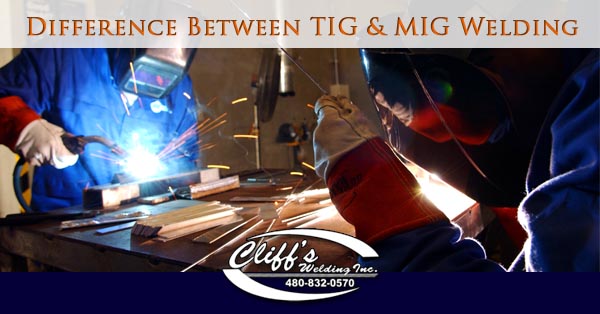
A lot of people ask us, “Is there any difference between MIG welding and TIG welding?” It is normal to be a little bit confused. Especially since the process for both of these uses electrical arcs, which produces heat too help the metallic objects join together. In fact, they both use an inert gas mixture which prevents corrosion of the welding electrodes. However, these two welding processes of electrical arc do have several key differences.
The key differences, and the way each of the processes work:
Metal inert gas (MIG) welding is a process involving a constant feed of metal wire for the weld to be made. The wire used acts as the filler material, helping the two metal objects being welded to join together.
Tungsten gas (TIG) welding is a process involving the use of non-consumable tungsten electrodes which carries an electric current through the metals being joined together. In fact, this process can be chosen to use a filler metal, or not too.
Suitable for the welding of thicker metal objects:
Since MIG welding uses a filler material that is consumable to make their welds, they can usually perform welds that consist of thicker metal objects in a shorter amount of time than the TIG weld can be performed. If a filler material is not being used it means that TIG welding will have to get the metal pieces that ate to be welded together hot enough that they will form a bond to each other, which is generally easier to do with thinner pieces of metal rather than the thicker pieces.
To sum it up, MIG welding would be the way to go if the heavy duty welding to be performed is of a thicker metal. However, if the metal to be used is a thinner metal, the most effective solution would be to go with the TIG welding.
Easier control:
In general, MIG is recommended for it is easier to use. Especially for first timers and/or non-professionals as the mistakes made are not as devastating as they would be with the TIG welding.
There is a much higher restriction over the control in TIG welding, as the timing, pressure, and the electrical current used in the welding process must be precise. These days you are going to find that the majority of the best work in TIG is performed on an automated Computer Numerically Controlled (CNC) welding machine. Manual welding cannot perform welds time and time again perfectly as a machine can do.
The settings for the welds and the controls have to be perfectly adjusted on the automatic welder, regardless if it is for the MIG or the TIG, otherwise, the same mistakes will continuously repeat themselves.
Which is the best?
The correct answer depends on the job at hand. As mentioned previously, for welding of large heavy duty work consisting of thicker metals being joined together, the MIG welding is typically the best because it used filler material.
However, for those smaller jobs consisting of small pieces of metal being joined together, the TIG would be the better one to use. Besides, since the process of TIG does not consist of using filler material to join the pieces together, there will be no failing to be concerned about.
Also, when using the robotic welding equipment, there will be less maintenance, this is due to the welding electrodes not having to be constantly used during the welding process. However, it will still be necessary to properly clean and polish the welding electrodes in between be used, more so if it is stainless steel being welded.
Phoenix Valley Welding Professionals
Cliff’s Welding of Mesa offers mobile welding and welding at our shop. We can handle a wide variety of projects from welding new hitches and other accessories on your vehicle to repairing or fabricating things you need for your truck or trailer. We even make custom football filming towers for use by educational facility’s sports teams. For for welding services please call 480.832.0570
